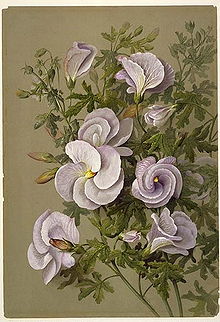Cygnis insignis (talk | contribs) italic |
m not a stub |
||
| Line 38: | Line 38: | ||
The species was grown in english greenhouses during the nineteenth century and is now grown in temperate climes of the United States of America and Europe. |
The species was grown in english greenhouses during the nineteenth century and is now grown in temperate climes of the United States of America and Europe. |
||
{{Rosid-stub}} |
|||
== Reference == |
== Reference == |
||
Revision as of 18:23, 28 August 2007
| Alyogyne huegelii | |
|---|---|

| |
| Scientific classification | |
| Kingdom: | |
| Division: | |
| Class: | |
| Order: | |
| Family: | |
| Genus: | |
| Species: | A. huegelii
|
| Binomial name | |
| Alyogyne huegelii | |
Alyogyne huegelii is a flowering plant found in the Southwest botanical province of Australia, extending along its entire coastline. Growing up to 2.5 metres, the species favours the sands of the coastal shrublands and heath. The large flower, highly variable in colour, is similar to that of Hibiscus, and it was previously placed in that genus. It is widely cultivated as a flowering plant for the garden, the varieties and cultivars previously published are no longer formally recognised.
Description
Shrub to four metres with many alternate branchs, although lower ones may be sparse. Bright green leaves are divided in three to five in outline; margins are irregular, lobate to toothed; pubescent and strongly veined lobes are coarse in shape. The flowerstalk at the leaf axil is long, tilting at the single flower.
Luminous petals, up to 70 mm long, are five; colour is cream or mauve, or the lilac of the name by which it is traded; petals are overlapping and have slight ridges. The staminal tube contains numerous whorled anthers, these are yellow. The five styles of this are fused except the tip, this is swollen and apparently divided stigma. This is supported on a five-lobed calyx within a set of up to 10 partly fused bracts.
As with all the Malvales, the flowers last around a day - becoming deeply coloured and papery when spent. They are numerous in the long flowering period between June and January.
Taxonomy
The species was formerly placed in Hibiscus as Hibiscus huegelii, taking its name from Baron von Huegel. The Alyogyne genus has since been revised and the varieties, such as Hibiscus huegelii var. leptochlamys (mauve) and Hibiscus huegelii var. wrayae (white) are no longer classed as subspecies or cultivars. Paul Fryxell, in the journal "Australian Plants" (1966), described the species as of two in a uniquely australian genus. Along with Hibiscus hakeifolia, it was transferred in 1968 to one of four Alyogyne species. Later revisions to FloraBase have included new species and previous classification of Alyogyne huegelii is being reordered within the genus.
Distribution
Preference for temperate and sandy coastal areas of the botanical province, predominantly those of the north and south mallee shrubland and heath. The distribution of the Alyogyne species in South Australia is likely to be that of another species.
Cultivation

by Ellis Rowan in the 1880s
A large number of variants in the species have been cultivated, the colours of white, cream, purple. lilac, mauve, and the somewhat erroneous blue are traded as varieties or cultivars. The natural variance of leaf form has also been exploited in the selection of plants for the market, fine or dissected leaves may have been hybridized with Alyogyne hakeifolia. The fomer name of Hibiscus huegelii, along with other synonyms, are still given in some sources.
Propogation is successful by cuttings, well drained soil, avoidance of frosts and the usual caution regarding phosphorus and species from the region is recommended. The sparse lower branching habit of the species, and inducement to a desirable habit, is achieved by heavy pruning after flowering.
The species was grown in english greenhouses during the nineteenth century and is now grown in temperate climes of the United States of America and Europe.
Reference
- ^ Fryxell, P.A. (1968) Proceedings of the Linnean Society of New South Wales Series 2 92(3): 265
- Rippey, Elizabeth (2004) [1995]. Coastal plants: Perth and the south-west region (2nd ed. ed.). Perth: University of Western Australia Press. pp. 42, 43. ISBN 1 920694 05 6.
{{cite book}}:|edition=has extra text (help); Unknown parameter|coauthors=ignored (|author=suggested) (help) - ANBG staff (1976) (16 December, 2003). " Alyogyne huegelii". Growing Native Plants. Australian National Botanic Gardens (ANBG). Retrieved 2007-08-27.
The best way to propagate A. huegelii is by half-hardened tip cuttings 7-8 cm long, although soft tip cuttings also do well.
{{cite web}}: Check date values in:|date=(help); Cite has empty unknown parameter:|coauthors=(help)CS1 maint: numeric names: authors list (link) - Colleen Keena (2002). "Alyogyne: An Update". Australian Plants online. Association of Societies for Growing Australian Plants. Retrieved 2007-08-27.
{{cite web}}: Unknown parameter|month=ignored (help)